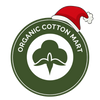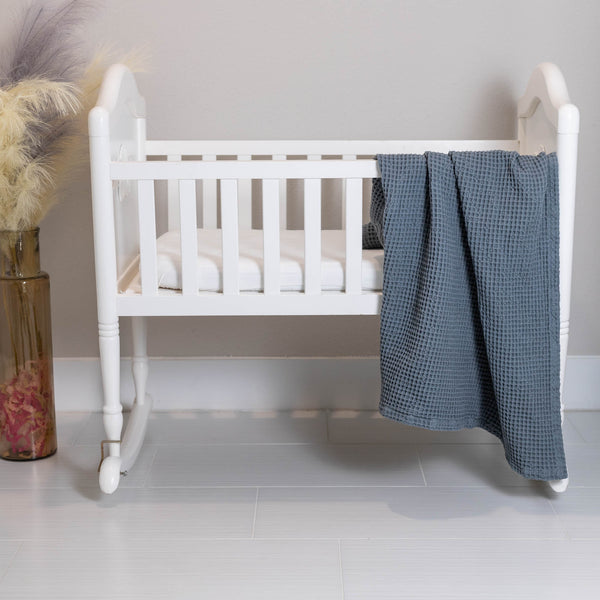One of the first things a baby feels against his brand-new skin is the softness, warmth, and comfort of a receiving blanket. That’s why every newborn is welcomed with one of these.
While most hospitals have a ready supply of these blankets, as a new parent, you may want to bring one of your own.
This blog is a crash course in receiving blankets, and by the time you’re done reading it, you’ll know their uses, benefits, fabric choice, and more!
Table of Contents
- What is a Receiving Blanket?
- Is a Baby Receiving Blanket Same as a Swaddle Blanket?
- 7 Most Popular Receiving Blanket Fabrics
- 7 Amazing Uses of Baby Receiving Blankets
- 1. Swaddle Blanket
- 2. Makeshift Diaper Changing Mat
- 3. Tummy Time Mat
- 4. Stroller Cover
- 5. Photograph Backdrop
- 6. Multi-purpose Mess Cleaners
- 7. Nursing Cover-up
- How to Use a Receiving Blanket - Safety Tips
- Final Thoughts
What is a Receiving Blanket?
The clue’s in the name - this is quite simply the first cloth you wrap a newborn in before handing them to the parents.
Considering how soft and sensitive a baby’s skin is, these blankets are silky smooth, lightweight, and hypoallergenic - typically made with 100% cotton, delicate muslin, or fuzzy flannel.
A receiving blanket is of enormous sentimental value and is generally retained as a keepsake by the baby’s family.
Here are the fantastic benefits of this blanket and why it should be the first item to pack in your hospital bag. Check our detailed guide to see the amazing checklist for mom and baby to pack in a Hospital Bag for Labor.
-
Super Soft: A receiving blanket isn’t just soft. It is one of the most delicate fabrics to touch, making it perfect for the arrival of your bundle of love. It’s also pretty breathable to reduce the risk of overheating. Your baby would always be snug, calm, and dry in one of these!
-
Small and Lightweight: These snuggly blankets are featherlight and allow good airflow. They come in various sizes, with the most common dimension of 30 inches x 30 inches - an ideal size to swaddle and wrap your baby comfortably.
-
Non-Toxic: Any cloth used for a newborn should be skin friendly or, in other words, non-bleached or non-dyed. To be super safe that the blanket you pick is hundred percent chemical-free, choose organic baby blankets.
-
Eco-Friendly: Blankets made from organic fabrics like cotton, muslin, and bamboo aren’t just gentle on your baby but also on the planet. Organic materials are grown with low-impact techniques and without chemicals, GMOs, or pesticides.
Is a Baby Receiving Blanket Same as a Swaddle Blanket?
A swaddling blanket is wrapped around the baby to mimic a womb-like environment. It helps them nap better and longer by maintaining their sleeping position while keeping startling reflexes at bay.
The only thing that sets the two types of blankets apart is the size - receiving blankets tend to be more compact as they’re designed for babies at their smallest. A receiving blanket can just as well be used to swaddle till you need a bigger size.
7 Most Popular Receiving Blanket Fabrics
Out of the endless list of items to buy for your baby’s arrival, a receiving blanket might be the most important. Here are the seven most widely used fabric choices and why they are ideal for baby blankets.
-
1. Muslin
A delicate gauze muslin blanket is a godsend for a baby born in the warmer months. It is skin-friendly, breathable, and not to mention extraordinarily soft and cozy. In fact, the more you wash these blankets, the softer they get. A muslin blanket is typically large (47 inches x 47 inches) for easy swaddling of wiggly babies.
-
2. Organic Cotton
Organic Cotton Muslin, flannel, jersey - there are a whole host of baby-friendly fabrics woven, knit, or felted using cotton fibers. You can also rely on good ol’ cotton in its natural form to bring your baby home. Even better if it’s organic. The earth-friendly organic cotton is produced using low-impact methods without pesticides, toxic chemicals, or genetically modified seeds.
-
3. Cotton Flannel
Winters and flannel is a match made in heaven! The soft, cozy, and durable flannel is woven cotton fabric with a napped finish on one or both sides. It’s thicker than muslin and fuzzy to the touch. While there are synthetic varieties of flannel available, we recommend only the highest-quality cotton flannel for your baby. Like muslin, flannel gets softer with every wash.
-
4. Jersey Knit
For cooler months, it’s best to go for a blanket made from cotton flannel or jersey knit, as these work brilliantly well in regulating body temperature. A jersey knit is quite like regular cotton in breathability but more robust, thick, and stretchy. Plus, you won’t face any piling or fraying hassles with this fabric. When buying a jersey knit blanket, make sure the edges are hemmed to prevent the ends from curling up.
-
5. Bamboo
When we say bamboo for a baby blanket, we mean organic bamboo. This fabric is soft, breathable, non-abrasive, and blessed with natural anti-microbial properties. On your quest for the perfect baby blanket, you might also come across blankets made of bamboo rayon. These come with all the goodness of bamboo while being extra stretchy, which is great for swaddling. However, we don’t recommend bamboo rayon for babies because of the chemically intensive manufacturing process.
-
6. Fleece
Soft, easy to maintain, quick drying, and super snug are some of the many qualities that make fleece a fantastic winter blanket fabric. But if you’re looking for a natural and sustainable material for your baby, synthetic fleece may not be such a good idea.
-
7. Wool
When it comes to regulating body temperature, wool trumps all. It also wicks moisture, keeping you comfy and dry as you sleep. For baby receiving blankets, softer and finer varieties of wool like merino would be your best bet, as ordinary wool might be too abrasive and harsh for a baby’s skin.
7 Amazing Uses of Baby Receiving Blankets
Your baby’s first few seconds out in the world are crucial - a soft and comforting receiving blanket will make their transition smoother. But there’s much more these blankets can do besides giving your baby the best snuggles. Here are seven different ways of using a receiving blanket.
-
1. Swaddle Blanket
The primary use of a white muslin swaddle, apart from wrapping a newborn baby, is using it as a swaddle cloth to induce long and disruption-free naps.
Many experts believe swaddling may have been invented anywhere from 4000 to 4500 years ago! This ancient technique works magically in recreating the confines of a womb - a baby’s first home.
It’s like one giant hug that keeps your baby safe from startling reflexes in their newborn days.Related Article: How to Swaddle Your Newborn? The Most Comprehensive Guide to Swaddling.
-
2. Makeshift Diaper Changing Mat
A flat piece of easy-to-wash and quick-drying cloth is all you need for a changing mat. And a baby blanket made from organic cotton fits the bill, holding up well, wash after wash. Just fold and store it in your diaper baby for sanitary, mess-free on-the-go diapering.
-
3. Tummy Time Mat
In the early months, a baby needs a few minutes of tummy time every day to strengthen their head, neck, and upper body and learn how to lift their head. Why buy a separate tummy time mat when you’ve got a receiving blanket around? These blankets usually come in packs of 2 or 3 to help with various baby activities apart from just swaddling.
-
4. Stroller Cover
You can never be too prepared while stepping out with your little one - This is why having one of these around with you all the time is a smart call. A receiving blanket can also act as a stroller cover to keep your newborn safe from insects, dust, and bright sunlight while on their daily strolls with you.
-
5. Photograph Backdrop
Most receiving blankets are usually unbleached and dyed, making them ideal for creating light and natural photography backdrops. You can buy an expensive fabric backdrop off the rack or use your baby’s blanket instead. We prefer the latter!
-
6. Multi-purpose Mess Cleaners
You can always cut it into smaller pieces if a receiving blanket feels too big to use as a burp cloth. Double gauze muslin blankets are great for cleaning spills, dribbles, and spit-ups, because of their high absorbency, easy care, and quick-drying qualities. And once your infant begins nibbling at solid foods, keep a bunch of these around, as babies can be messy eaters!
Related Article: 20 Sustainable Baby Products You Should Try and Switch to.
-
7. Nursing Cover-up
A 30-inch x 30-inch or a 30-inch x 40-inch receiving blanket is a decent size to be used as a breastfeeding cover-up. Also, storing these blankets in your handbag or diaper bag is absolutely hassle-free, thanks to their compact dimensions.
We recently came up with a list of 15 Best Blanket Storage Ideas that will make you organized. You may want to explore these creative solutions to keep your space clutter-free.
How to Use a Receiving Blanket - Safety Tips
As helpful as blankets are, they also pose a safety risk if not used carefully. Here are a few things to remember when using any type of baby blanket.
- Do not place the blanket or any loose bedding in the crib while your baby sleeps.
- Make sure your baby is supervised at all times, and the blankets in no way restrict their breathing.
- Swaddling should be done firmly but not tightly to reduce the risk of overheating.
- If you’re swaddling, do it right from birth, and not when the baby is two to three months old when the risk of SIDS is the highest.
For a detailed safety guide, please go through the pointers put together by the American Academy of Pediatrics (AAP) to prevent sleep-related mishaps.
Final Thoughts
The usefulness of a receiving blanket isn’t just restricted to welcoming or swaddling a baby in their newborn days. It’s a multi-functional cloth that’ll help you long after your baby’s birth. And after it’s served you well, you can craft it into a pillow cover or a memory quilt as a precious keepsake.
Organic cotton waffle throw blanket is just a best option for individuals of all ages, from newborns to the elderly, as they provide a soft and breathable layer of comfort, promoting warmth and security while adding a touch of coziness to any age group.

